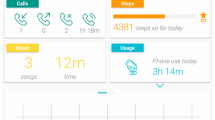Abstract
Mobile devices collect a variety of information about their environments, recording “digital footprints” about the locations and activities of their human owners. These footprints come from physical sensors such as GPS, WiFi, and Bluetooth, as well as social behavior logs like phone calls, application usage, etc. Existing studies analyze mobile device footprints to infer daily activities like driving/running/walking, etc. and social contexts such as personality traits and emotional states. In this paper, we propose a different approach that uses multimodal mobile sensor and log data to build a novel user modeling framework called mFingerprint that can effectively and uniquely depict users. mFingerprint does not expose raw sensitive information from the mobile device, e.g., the exact location, WiFi access points, or apps installed, but computes privacy-preserving statistical features to model the user. These descriptive features obscure sensitive information, and thus can be shared, transmitted, and reused with fewer privacy concerns. By testing on 22 users’ mobile phone data collected over 2 months, we demonstrate the effectiveness of mFingerprint in user modeling and identification, with our proposed statistics achieving 81% accuracy across 22 users over 10-day intervals.
Access this chapter
Tax calculation will be finalised at checkout
Purchases are for personal use only
Preview
Unable to display preview. Download preview PDF.
Similar content being viewed by others
References
The Funf Open Sensing Framework, http://www.funf.org/
Angulo, J., Wästlund, E.: Exploring touch-screen biometrics for user identification on smart phones. In: Camenisch, J., Crispo, B., Fischer-Hübner, S., Leenes, R., Russello, G. (eds.) Privacy and Identity Management for Life. IFIP AICT, vol. 375, pp. 130–143. Springer, Heidelberg (2012)
Campbell, A.T., Eisenman, S.B., Lane, N.D., Miluzzo, E., Peterson, R.A., Lu, H., Zheng, X., Musolesi, M., Fodor, K., Ahn, G.-S.: The rise of people-centric sensing. IEEE Internet Computing 12(4), 12–21 (2008)
Chittaranjan, G., Blom, J., Gatica-Perez, D.: Who’s who with big-five: Analyzing and classifying personality traits with smartphones. In: ISWC, pp. 29–36 (2011)
de Montjoye, Y.-A., Hidalgo, C.A., Verleysen, M., Blondel, V.D.: Unique in the crowd: The privacy bounds of human mobility. Scientific Reports 3 (2013)
de Montjoye, Y.-A., Quoidbach, J., Robic, F., Pentland, A(S.): Predicting personality using novel mobile phone-based metrics. In: Greenberg, A.M., Kennedy, W.G., Bos, N.D. (eds.) SBP 2013. LNCS, vol. 7812, pp. 48–55. Springer, Heidelberg (2013)
Do, T.M.T., Gatica-Perez, D.: Contextual conditional models for smartphone-based human mobility prediction. In: Ubicomp, pp. 163–172 (2012)
Kwapisz, J.R., Weiss, G.M., Moore, S.A.: Activity recognition using cell phone accelerometers. ACM SIGKDD Explorations Newsletter 12(2), 74–82 (2011)
LiKamWa, R., Liu, Y., Lane, N.D., Zhong, L.: Moodscope: building a mood sensor from smartphone usage pattern. In: Mobisys (2013)
Lu, H., Pan, W., Lane, N.D., Choudhury, T., Campbell, A.T.: Soundsense: scalable sound sensing for people-centric applications on mobile phones. In: MobiSys. ACM (2009)
Rachuri, K.K., Musolesi, M., Mascolo, C., Rentfrow, P.J., Longworth, C., Aucinas, A.: Emotionsense: a mobile phones based adaptive platform for experimental social psychology research. In: Ubicomp, pp. 281–290 (2010)
Shin, C., Hong, J.-H., Dey, A.K.: Understanding and prediction of mobile application usage for smart phones. In: Ubicomp, pp. 173–182 (2012)
Weppner, J., Lukowicz, P.: Collaborative crowd density estimation with mobile phones. In: SenSys (2011)
Yan, Z., Chakraborty, D., Parent, C., Spaccapietra, S., Aberer, K.: Semitri: a framework for semantic annotation of heterogeneous trajectories. In: EDBT, pp. 259–270 (2011)
Yan, Z., Yang, J., Tapia, E.M.: Smartphone bluetooth based social sensing. In: Ubicomp, pp. 95–98 (2013)
Author information
Authors and Affiliations
Editor information
Editors and Affiliations
Rights and permissions
Copyright information
© 2014 Springer International Publishing Switzerland
About this paper
Cite this paper
Zhang, H., Yan, Z., Yang, J., Tapia, E.M., Crandall, D.J. (2014). mFingerprint: Privacy-Preserving User Modeling with Multimodal Mobile Device Footprints. In: Kennedy, W.G., Agarwal, N., Yang, S.J. (eds) Social Computing, Behavioral-Cultural Modeling and Prediction. SBP 2014. Lecture Notes in Computer Science, vol 8393. Springer, Cham. https://doi.org/10.1007/978-3-319-05579-4_24
Download citation
DOI: https://doi.org/10.1007/978-3-319-05579-4_24
Publisher Name: Springer, Cham
Print ISBN: 978-3-319-05578-7
Online ISBN: 978-3-319-05579-4
eBook Packages: Computer ScienceComputer Science (R0)




